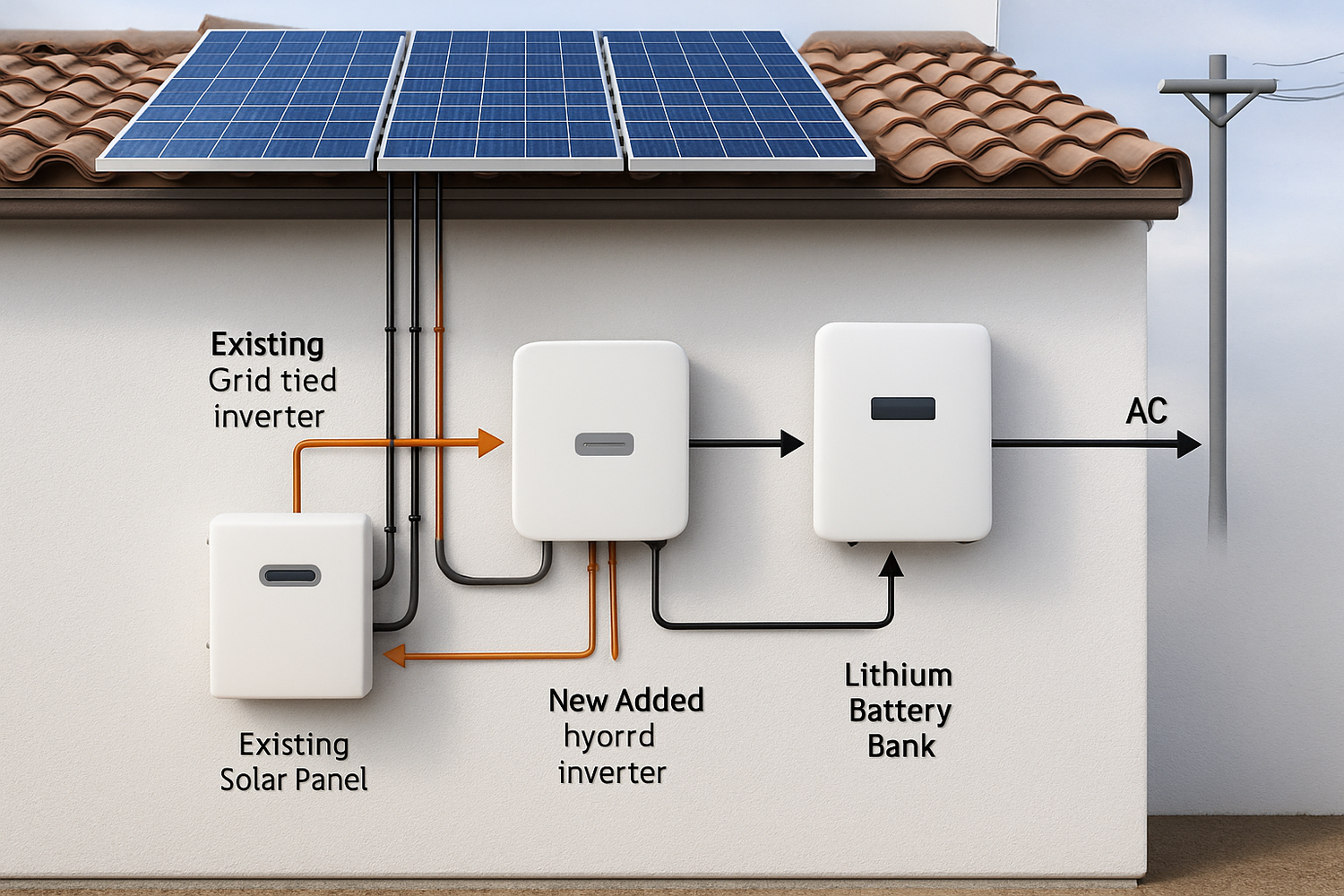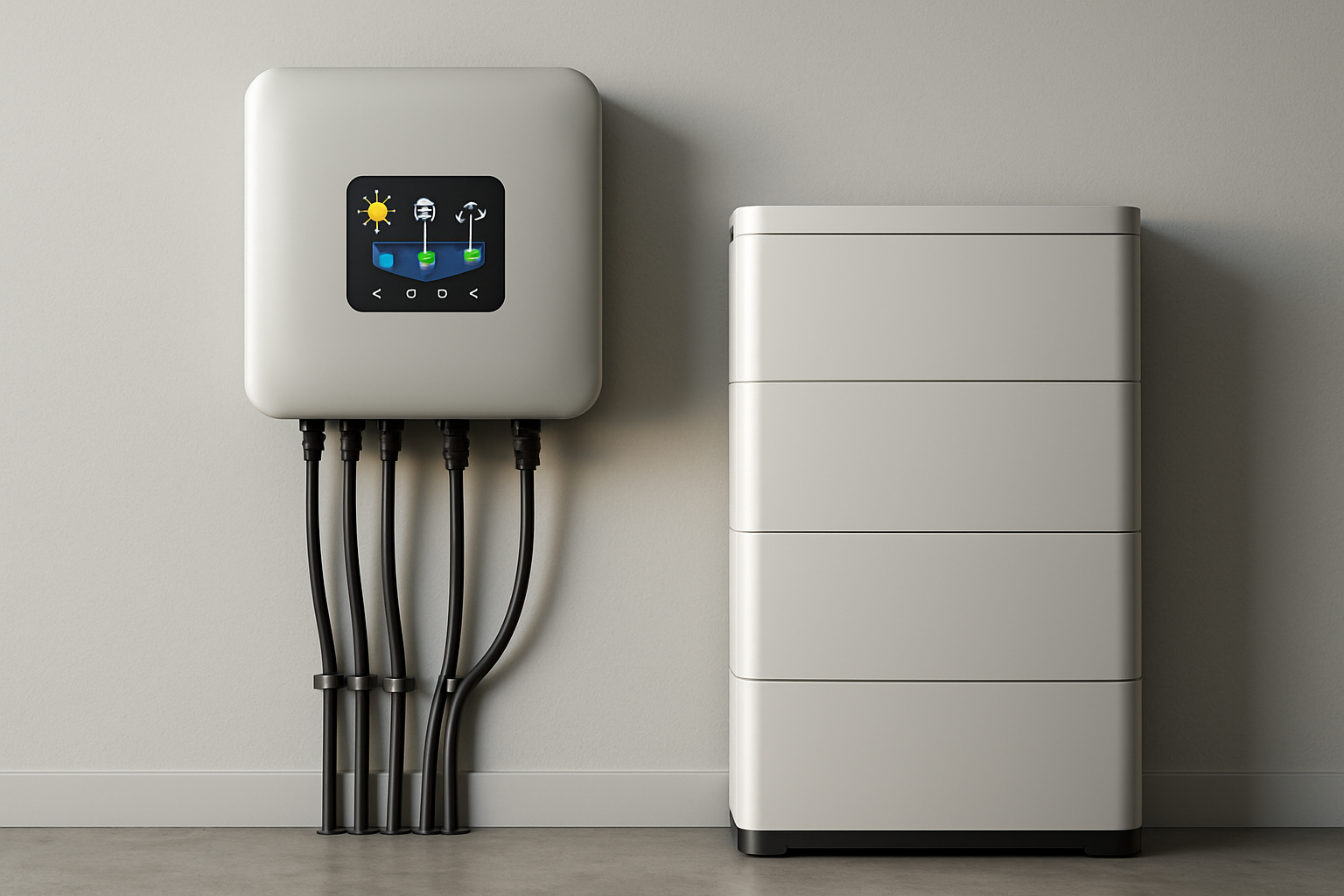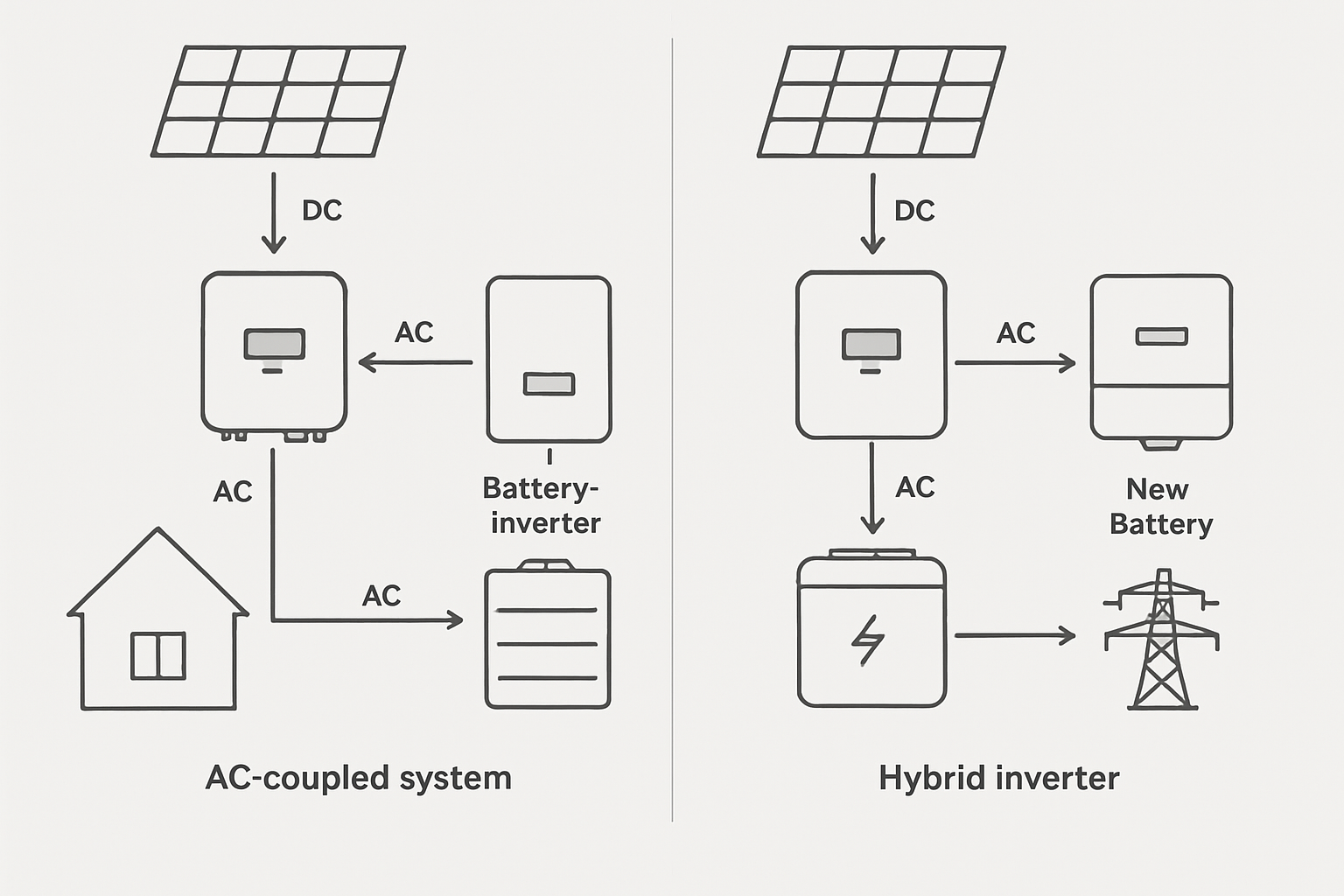Adding battery storage to an existing solar panel system is an effective way to increase energy independence and resilience. For homeowners who already have a grid-tied solar installation, AC coupling with a hybrid inverter presents a streamlined and powerful solution. This guide offers a detailed look into the technical aspects of AC coupled hybrid inverter systems, their components, and how they function, providing a clear roadmap for a successful energy storage upgrade.
Understanding AC Coupling in Solar Storage Systems
AC coupling is a method for integrating battery storage into a solar energy system. It's particularly well-suited for retrofitting batteries onto installations that already have a grid-tied solar inverter. The core principle is straightforward and flexible.
What is AC Coupling?
In a typical solar setup, panels produce direct current (DC) electricity, which a solar inverter converts into alternating current (AC) for your home's use. In an AC-coupled system, this AC power is used to charge a battery. This is accomplished by adding a battery-capable inverter that converts the AC power back to DC to be stored in the battery. When power is needed from the battery, it's converted back to AC. This configuration allows a battery system to be added with minimal disruption to the existing solar array.
The Central Role of the Hybrid Inverter
A hybrid inverter is a multi-functional device that can manage power from solar panels, the electrical grid, and a battery bank. In an AC-coupled configuration, the hybrid inverter acts as the intelligent core of the storage system. It directs the flow of energy, deciding when to charge the battery with excess solar power, when to discharge the battery to power the home, and when to draw from or send power to the grid. This capability makes it an ideal all-in-one solution for adding storage to an existing solar installation.
Key Scenarios for AC Coupling
The primary application for AC coupling is upgrading an existing grid-tied solar system. If you have solar panels and a solar inverter but no battery, AC coupling allows you to add storage without replacing your current inverter. This approach reduces installation complexity and cost, making it a popular choice for homeowners looking to enhance their energy resilience and maximize self-consumption of solar power.
A Technical Look at AC Coupled Hybrid Inverters
Understanding the technical workings of an AC-coupled system reveals its efficiency and robust design. The interaction between components is precisely managed to ensure reliable power delivery, both when the grid is active and during an outage.
System Architecture and Power Flow
An AC-coupled storage system consists of the original solar panels and their grid-tied inverter, plus a new hybrid inverter and a battery bank, such as a 48V LiFePO4 battery. The existing solar inverter and the new hybrid inverter are both connected to your home's main electrical panel. This parallel connection is what defines the AC-coupled architecture. Power from the solar panels is converted to AC and can either power the home directly, be exported to the grid, or be routed to the hybrid inverter to be converted back to DC for battery charging.
Power Conversion and Efficiency
AC-coupled systems involve multiple power conversions (DC to AC from the solar inverter, then AC to DC for battery charging). While this results in small energy losses at each stage, modern high-efficiency inverters minimize this effect. The round-trip efficiency of an AC-coupled system is typically around 85-90%. While slightly lower than some DC-coupled systems, the flexibility and ease of retrofitting often make this a worthwhile trade-off. As the International Energy Agency (IEA) notes, advancements in smart inverter technology continue to improve overall system efficiency and grid stability.
Grid Interaction and Frequency Shifting
A critical technical feature of AC-coupled systems is their ability to function during a grid outage. When the grid fails, the hybrid inverter disconnects from it and creates its own stable mini-grid. To prevent the solar inverter from sending power to a dead grid (a safety hazard known as islanding), the hybrid inverter uses a technique called frequency shifting. It slightly alters the frequency of the AC power in the mini-grid. The grid-tied solar inverter detects this frequency change and throttles its output or shuts down, preventing it from overcharging the battery.
Sizing and Selecting Your AC Coupled System
Properly sizing your hybrid inverter and battery is essential for meeting your energy goals. This involves assessing your power needs, understanding battery specifications, and ensuring all components work together seamlessly.
Sizing the Hybrid Inverter
The hybrid inverter's power rating (in kilowatts) should be based on the maximum amount of power you need to supply to your critical loads simultaneously during an outage. It is not directly tied to the size of your solar array. Sum up the wattage of essential appliances like your refrigerator, lights, and communication devices to determine an appropriate inverter size.
Choosing the Right Battery
The battery's capacity (in kilowatt-hours) determines how long you can power your home. Lithium Iron Phosphate (LiFePO4) batteries are a leading choice for home energy storage due to their long cycle life, safety, and high efficiency. When selecting a battery, it's important to consider its performance metrics. Key factors like Depth of Discharge (DoD) and cycle life directly impact the battery's usable capacity and longevity, as explained in this ultimate reference on solar storage performance. According to a report from the International Renewable Energy Agency (IRENA), the costs for battery storage systems are projected to fall significantly, making these upgrades increasingly accessible.
Compatibility and Integration
Ensure the hybrid inverter and battery you select are compatible. Manufacturers typically provide a list of approved batteries for their inverters. This guarantees proper communication and performance. The hybrid inverter must also be able to effectively manage the existing solar inverter through frequency shifting, a standard feature in modern systems designed for AC coupling.
Installation and Financial Considerations
The process of adding an AC-coupled system is relatively non-invasive. Understanding the costs and available incentives can help you make a sound financial decision.
The Installation Process
Installing an AC-coupled system is generally simpler than other retrofit options. An electrician or certified installer will connect the hybrid inverter and battery to your main electrical panel. Because the existing solar array and its wiring are left untouched, the installation process is often faster and less labor-intensive.
Cost Analysis and Incentives
The primary costs are the hybrid inverter, the battery bank, and installation labor. While a significant investment, AC coupling saves you from having to replace your existing solar inverter. Furthermore, various government incentives can reduce the overall cost. The U.S. Department of Energy provides information on federal tax credits and state-level rebate programs for energy storage. These incentives are designed to encourage the adoption of technologies that enhance grid reliability and promote renewable energy use.
Disclaimer: This article is for informational purposes only and does not constitute financial or legal advice. Please consult with a qualified professional before making any investment decisions.
A Path to Enhanced Energy Control
For those with an existing solar installation, AC coupling with a hybrid inverter offers a practical and powerful pathway to energy storage. This approach minimizes disruption, leverages your current investment, and provides a robust solution for backup power and increased solar self-consumption. By carefully selecting components and understanding the system's operation, you can achieve greater control over your energy future and enhanced security for your home.
Frequently Asked Questions
Can I use any battery with an AC-coupled hybrid inverter?
No, it is important to select a battery that is listed as compatible by the inverter manufacturer. This ensures that the battery management system (BMS) can communicate correctly with the inverter, which is crucial for safety, performance, and longevity.
Is AC coupling less efficient than DC coupling?
AC coupling involves an extra energy conversion step, which can lead to slightly lower round-trip efficiency compared to DC coupling. However, modern, high-quality inverters have efficiencies of 95% or higher, making the real-world difference minimal for most residential applications. The ease of installation for retrofits often outweighs the minor efficiency difference.
What happens during a power outage with an AC-coupled system?
During a power outage, the hybrid inverter will disconnect from the grid and form a local, independent grid for your home. It will supply power from the battery to your designated backup loads. It also controls the output of your original solar inverter using frequency shifting to ensure the battery is not overcharged by solar production.
Do I need to replace my current solar inverter to add a battery?
No, the main advantage of AC coupling is that you do not need to replace your existing solar inverter. The new hybrid inverter and battery system work in parallel with your current setup, making it an ideal solution for retrofitting storage onto an existing solar installation.





Leave a comment
All comments are moderated before being published.
This site is protected by hCaptcha and the hCaptcha Privacy Policy and Terms of Service apply.